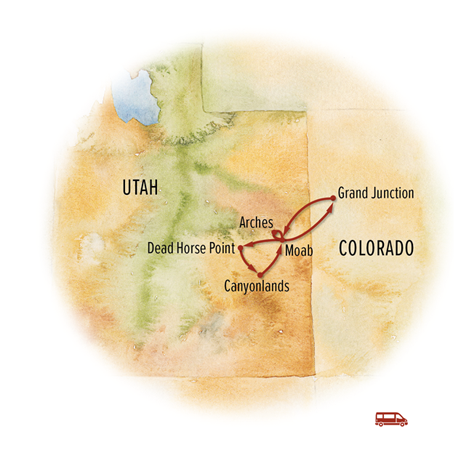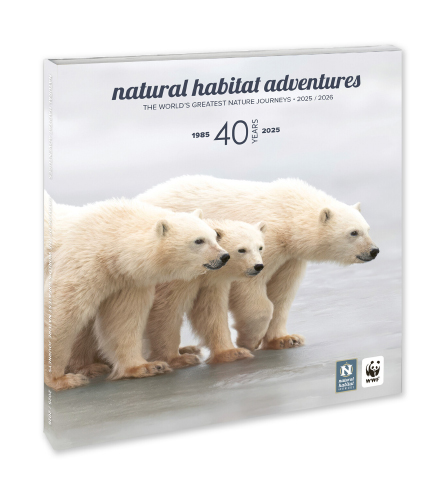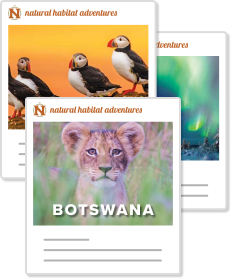Itinerary
A once humble railroad hub and ranching outpost in western Colorado, Grand Junction has flourished into an agricultural center and vibrant university town renowned for its farm-to-table fare, abundant microbreweries and nearby Palisade wines. It’s also a gateway to adventure, especially for the scenic Utah desert that lies nearby.
Our adventure officially begins this evening with a welcome dinner with our Expedition Leaders and fellow travelers. However, guests who arrive before 1 pm may join an optional guided tour to the Colorado National Monument, one of the state’s best kept secrets. Although it is filled with stunning red rock canyons and monoliths like the better-known national parks in the region, the monument remains less visited than its more famous neighbors. Following the scenic 23-mile Rim Rock Drive, we climb more than 2,000 feet in elevation. Completed in 1950, the winding two-lane road features three historic tunnels carved through solid rock, with scenic pullouts and commanding views of sweeping canyons, the lone sandstone tower of Independence Monument, and the distant peaks of the Rocky Mountains.
Day 2: Moab, Utah—Klondike Bluffs / Colorado River Float
Today we delve farther into the Colorado Plateau, a vast landscape covering 130,000 square miles across parts of Colorado, Utah, Arizona and New Mexico. The plateau is characterized by higher elevations (between 5,000 and 7,000 feet), an arid climate, and its distinctive geology of canyons, flat-topped mesas and colorful rock formations. From Grand Junction, we continue west to Moab, less than two hours away. Our first destination is Klondike Bluffs, where we encounter ancient history etched into the rock. On a hike along the Dinosaur Stomping Grounds Trail, we cross a rugged desert landscape of slickrock and juniper to reach a site where dinosaur tracks are preserved in the sandstone. These 190-million-year-old footprints, left by long-extinct creatures during the Jurassic period, offer a tangible connection to the prehistoric world. As we trace their footsteps, we have a sweeping view of Arches National Park—a preview for tomorrow. This afternoon, enjoy a scenic float on the famous Colorado River through Castle Valley (weather permitting) before settling in to our comfortable base at Red Cliffs Lodge, peacefully located well outside the busy adventure town of Moab. Perched on the edge of the Colorado River beneath imposing canyon walls, the lodge is our high-desert home for the next three nights.
Day 3: Arches National Park / Petroglyphs / Deadhorse Point State Park
Few geological phenomena are as emblematic of a place than the 2,000-plus sandstone arches within Arches National Park. These rock formations are the physical evidence of the power of erosion, as wind, rain, sun and time converge to shape the malleable landscape. The Entrada Sandstone, which comprises most of the park’s arches, is particularly susceptible to erosion due to its composition. Water seeps into cracks, freezes and expands, breaking the rock apart, while wind carries away loose particles. The result is an intricate tableau of stone shapes that evoke wonder and whimsy at every turn.
Our day dawns with sunrise in Arches National Park, where we experience the wonder of first light transforming the landscape with a shifting palette of warm hues. The towering sandstone formations seem to glow from within, their red and orange tones deepened by the intesifying sun's rays. Shadows stretch long across the desert floor, creating striking contrasts that highlight the textures and contours of the rugged terrain. The morning continues with a hike to Delicate Arch, the most recognizable arch in the park and, perhaps, the world. The play of light on rock highlights the natural beauty of the sandstone and surrounding landscape, showcasing nature's geological artistry in new and shifting perspectives. Witnessing this icon up close, we'll surely concur with Edward Abbey who wrote in Desert Solitaire, "If Delicate Arch has any significance, it lies, I will venture, in the power of the odd and unexpected to startle the senses and surprise the mind out of their ruts of habit, to compel us into a reawakened awareness of the wonderful—that which is full of wonder.” The remainder of the morning is devoted to exploring more of the park's natural arches and trails with our Expedition Leader, who excels at finding moments of solitude to contemplate the wonders before us.
In the afternoon, we stop to view ancient petroglyphs etched into the canyon walls by the ancestral Puebloan people who inhabited this region some 2,000 years ago. These rock carvings offer insight into the lives and worldview of the area’s early inhabitants, depicting animals, human figures and geometric patterns. Continue to Deadhorse Point State Park, situated atop a plateau 2,000 feet above the Colorado River. Our view from the rim offers a comprehensive survey of the region’s geography, from the winding river below to the distant La Sal Mountains. The vista from Dead Horse Point is one of the most photographed in the world, capturing a dramatic bend in the Colorado River, held between vertical walls of stacked sandstone. Our vantage also includes vast stretches of Canyonlands National Park with its maze of canyons, mesas, buttes, fins, arches and spires. As the sun begins to dip toward the horizon and day fades to dusk, the sky becomes a pastel melange of orange, purple, pink and ochre.
Day 4: Canyonlands National Park—Needles District / Dark Sky Experience
Today is devoted to exploring Canyonlands National Park, a vast red rock wilderness carved by the Colorado and Green rivers over millions of years. The park’s varied geography spans four distinct sectors, and we focus on the less-visited and more remote Needles District, named for its dramatic spires of Cedar Mesa sandstone—colorful, banded rock pinnacles that rise like sentinels on the landscape. On a hike, we explore at closer range, following a winding trail across slickrock expanses and past ancient rock art, offering an intimate connection to the park's dramatic geology and cultural history.
After a picnic lunch, continue deeper into the park on off-road journey in our 4x4 adventure cruisers. Our destination offers a spectacular view of the Colorado River as it carves its way through the layers of sandstone comprising this landscape. As the day winds down, return to Red Cliffs Lodge in time for a sunset toast on the banks of the Colorado River. The fading light bathes the canyon walls in warm, golden tones, reflecting off the gleaming water as the desert transitions into twilight. After a last dinner together, we head out to experience one of the region’s most awe-inspiring spectacles: the dark night sky. Far from city lights, the inky black tableau reveals a glittering expanse of stars, planets, and the ethereal glow of the Milky Way, and our Expedition Leader helps us spot constellations rarely seen in more urban realms. With the silence of the desert as our backdrop, we spend meditative time taking in the grandeur of the cosmos, a timeless reminder of nature's vast beauty and mystery.
Day 5: Sunrise over the Colorado River / Upper Colorado River Scenic Byway / Grand Junction / Depart
Rise early to witness the sunrise this morning on a quiet walk along the Colorado River. Given our lodge’s optimal location, we don’t have to go far to experience this daily splendor. After breakfast, it's time to start making our way back to Grand Junction along the 44-mile Upper Colorado River Scenic Byway, a winding two-lane road that traces the river’s path through a dramatic gorge. Passing through Castle Valley, look for the famous profiles of Castleton Tower and Fisher Towers, observing how the gleaming light of morning transforms them from maroon to vermillion, then rust and gold. The surrounding terrain has been featured in many movies, including famous westerns, which are remembered at the Moab Museum of Film & Western Heritage located at Red Cliffs Lodge. Cross the Colorado River at the site of Dewey Bridge, which was the original wooden span carrying Highway 128 over the river. Built in 1916, the famous suspension bridge was the second longest west of the Mississippi and was listed on the National Register of Historic Places until it was destroyed by a fire in 2008. Once we’re back in Grand Junction, you may enjoy exploring this lively western town on your own if your flight schedule permits.

























